Red light therapy offers a natural way to target joint pain using specific wavelengths of light that penetrate deep into your tissues. You’ll benefit from wavelengths between 600-850nm, which activate cellular healing and reduce inflammation where you need it most. This FDA-cleared treatment boosts your body’s energy production through enhanced ATP release, improving blood flow and accelerating tissue repair. It’s especially effective for arthritis and musculoskeletal conditions, with many people experiencing relief within 1-2 weeks of consistent use. When combined with gentle exercise and proper treatment protocols, you’ll discover a powerful solution for long-term joint health management.
Understanding Red Light Healing Power
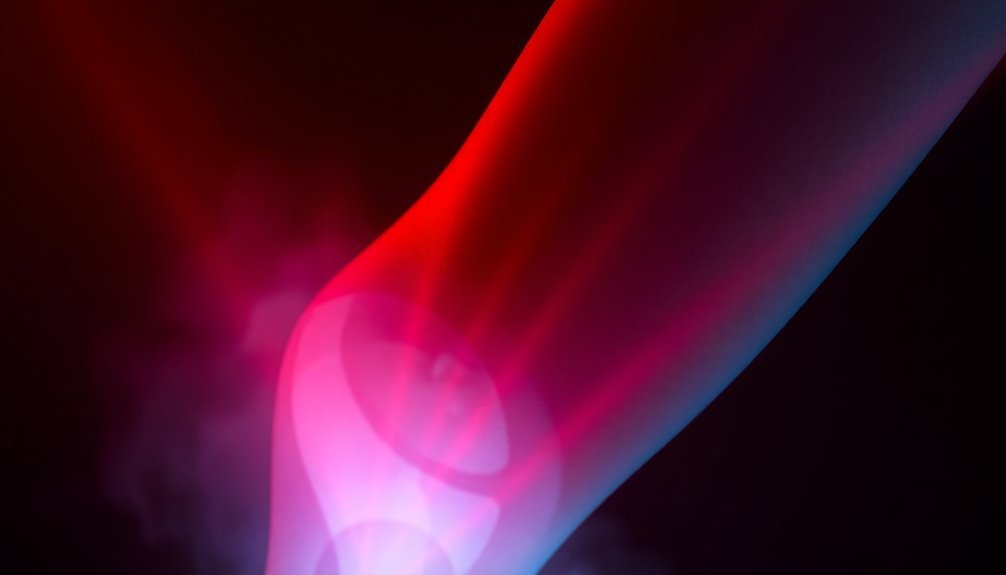
The power of light to heal has fascinated scientists and medical professionals for decades. Through NASA’s research and numerous clinical studies, we now understand that red light therapy offers a natural solution for joint pain and tissue recovery.
When you expose your body to specific wavelengths of red light, it triggers a cascade of healing responses at the cellular level. This therapy can penetrate 8-10 millimeters deep into your skin tissue.
Your cells’ mitochondria, the powerhouses that generate energy, become activated when exposed to red light. This boost in cellular energy production leads to increased collagen synthesis, enhanced blood flow, and reduced inflammation – all essential elements for joint health.
You’ll find that the therapy works by stimulating the release of nitric oxide, which improves circulation to your joints and accelerates tissue healing.
The FDA has cleared red light therapy for treating chronic joint pain, and it’s particularly effective because it addresses pain at its source. Rather than masking symptoms, the light penetrates deep into your tissues, where it promotes healing by reducing oxidative stress and modulating inflammation.
The therapy’s ability to enhance cellular energy production through increased adenosine triphosphate release means you’re not just treating pain – you’re actively supporting your body’s natural healing processes.
Joint Pain Science
Understanding how joint pain affects your body starts with recognizing its complex biological mechanisms. Your joints can suffer from various types of arthritis, with osteoarthritis and rheumatoid arthritis being the most prevalent. When cartilage breaks down or your immune system attacks joint tissues, you’ll experience inflammation, swelling, and structural changes that limit mobility. Recent research initiatives like RE-JOIN Consortium are exploring new non-opioid strategies for managing chronic joint pain.
You’ll notice several key symptoms that signal joint problems:
- Pain and stiffness that typically worsen with age
- Morning stiffness that improves with movement
- Swelling and tenderness around affected joints
- Limited range of motion during daily activities
Scientists are actively researching joint pain using advanced techniques like 3D imaging and mouse models to map nerve pathways and understand joint innervation. This research focuses on how nerves in your joints change with disease and injury, leading to more targeted treatment approaches.
Your treatment options can include medications, physical therapy, and surgical interventions, depending on the severity and cause of your joint pain. Current research is moving toward personalized treatments that consider your specific condition and symptoms, making pain management more effective and tailored to your needs.
Wavelength Benefits For Joint Health
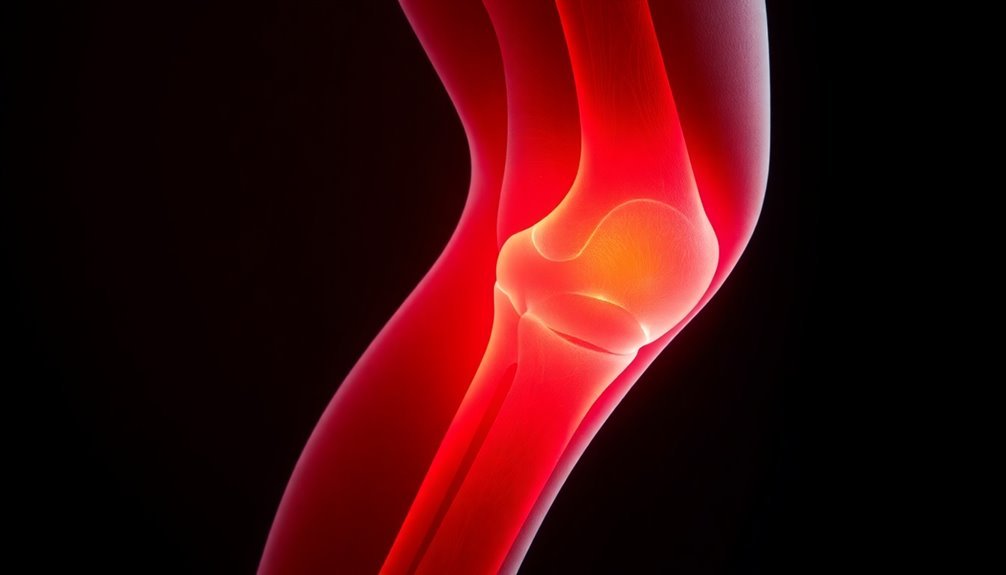
Diving into the science of light therapy reveals powerful solutions for managing joint pain and inflammation. You’ll find that different wavelengths of light offer unique healing properties for your joints, with red and near-infrared light leading the therapeutic charge. Clinical research confirms these therapeutic benefits for joint conditions.
When you’re dealing with surface-level joint pain, visible red light at 660nm penetrates a few millimeters deep, perfect for addressing superficial inflammation. For deeper joint issues, near-infrared wavelengths like 810nm, 850nm, and 940nm reach further into your tissues, stimulating cellular repair and reducing chronic pain.
| Wavelength | Penetration | Primary Benefits |
|---|---|---|
| 660nm Red | Superficial | ATP production, surface inflammation |
| 810nm NIR | Deep | Bone repair, nerve health |
| 850nm NIR | Medium-Deep | Tissue regeneration, recovery |
| 940nm NIR | Deepest | Deep tissue healing, systemic relief |
You’ll get the most thorough relief by combining wavelengths. This dual approach targets both surface-level discomfort and deep tissue healing simultaneously. The combination enhances blood flow, supports collagen production, and triggers your body’s natural healing mechanisms, offering you a complete solution for joint health restoration.
Light Therapy Treatment Methods
To get the best results from light therapy, you’ll need to position your device 6-12 inches from the target joint area for 10-20 minutes per session.
You can enhance your treatment by combining gentle stretches or range-of-motion exercises while using red light therapy on your joints. Near-infrared light penetrates deeply to provide pain-reducing effects during treatment sessions.
For ideal healing, it’s recommended to undergo light therapy treatments 3-5 times per week, adjusting the duration and positioning based on your specific joint condition and device type.
Treatment Duration Guidelines
For best results with light therapy treatments, following the correct duration guidelines is essential. You’ll need to commit to 15-20 minutes daily for red light therapy targeting joint pain, while SAD and depression treatments typically require 30-60 minutes per session. Patients should position themselves at 11 to 30 inches from the light source for optimal exposure.
Consistency is vital – you’ll want to maintain your treatment schedule seven days a week at the same time each morning.
- Start with shorter sessions of 15 minutes if you’re new to light therapy, then gradually increase duration based on your response.
- Expect initial improvements within 1-2 weeks, though full benefits may take 3-6 weeks to develop.
- If you’re not seeing results after 4 weeks, consider extending sessions up to 2 hours for depression treatment.
- Monitor your progress and adjust session length based on symptom improvement.
Once you’ve achieved significant improvement in joint pain, you can reduce red light therapy sessions to a few times per week for maintenance. Remember that brighter light intensity (10,000 lux) allows for shorter treatment times, but you’ll need to maintain the proper distance from the light source to achieve the best results.
The key to success lies in maintaining consistent daily treatments until you reach your desired outcome.
Light Positioning For Joints
Proper positioning of light therapy devices plays a critical role in achieving maximum joint pain relief. You’ll need to place the device directly on the affected joint to guarantee consistent light penetration and therapeutic benefits.
For deeper tissue treatment, infrared light (700-1200nm) effectively reaches muscles and joints, while red light (630-660nm) works best for surface-level healing. Regular treatments of 2-3 times per week help maintain long-lasting pain relief results.
When treating specific joints, secure your device firmly but comfortably using adjustable straps. You’ll want to position it precisely on knees, shoulders, ankles, or other problem areas to maximize light absorption.
The MOVE+ and similar devices offer versatile placement options, allowing you to target various joints effectively.
To enhance your treatment, you’ll need to think about the depth of penetration required. For conditions like arthritis or tendonitis, proper positioning guarantees both red and infrared light reach the intended tissues.
Your device should remain stable throughout the session, but don’t over-tighten the straps, especially around sensitive areas like your neck.
Combining With Movement Therapy
Three powerful treatment approaches emerge when combining light therapy with movement exercises. When you pair these therapies, you’ll accelerate healing while strengthening joints and surrounding tissues.
The combination works synergistically – light therapy reduces inflammation and stimulates collagen production, while movement improves flexibility and builds supporting muscles. Regular sessions help minimize joint damage and support long-term joint function.
- Combine red light sessions with low-impact exercises like swimming or cycling for enhanced joint pain relief
- Schedule light therapy before yoga or pilates to improve your range of motion and flexibility
- Use light therapy after resistance training to boost muscle recovery and joint repair
- Integrate light treatments with physical therapy exercises for maximum therapeutic benefit
Clinical research confirms that this dual approach delivers superior results compared to using either therapy alone. You’ll experience faster pain reduction and improved mobility as the light therapy supports tissue regeneration while movement maintains joint function.
For arthritis management, this combination proves especially effective – the light therapy reduces inflammation and promotes cartilage recovery, while targeted exercises strengthen the supporting structures around affected joints. By addressing both inflammation and physical limitations simultaneously, you’ll develop a more thorough treatment strategy for long-term joint health.
Clinical Research Findings
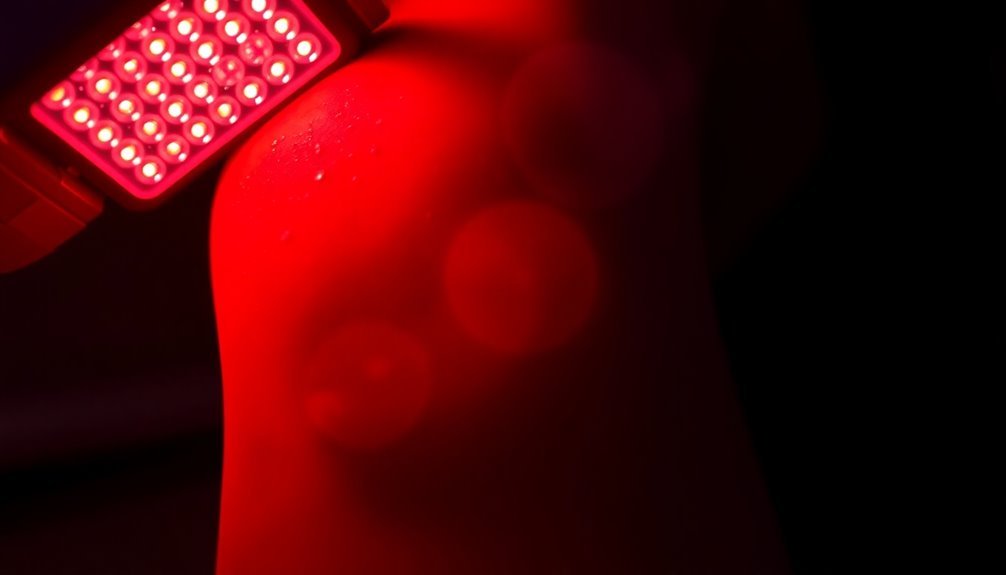
Research shows you’ll find significant pain relief through natural treatments backed by clinical studies, with acupuncture and mindfulness meditation demonstrating particularly strong outcomes for joint-related discomfort.
Acupuncture has been shown to stimulate the release of endorphins, modulate nervous system activity, and improve blood circulation, all of which contribute to its pain-relieving effects. It is effective for various types of pain, including headaches, back pain, and arthritis, and research supports its use. Monthly yoga practice can significantly reduce pain symptoms within 12 weeks of starting.
Mindfulness meditation, especially mindfulness meditation, can help relieve chronic pain and the depression that often comes with it. Scientific studies have found that mindfulness meditation improves pain and depression symptoms and quality of life. It helps control pain by reducing pain intensity, improving function, and enhancing quality of life.
Light therapy wavelengths between 600-850 nanometers have proven most effective at penetrating joint tissue and promoting cellular repair, while capsaicin and ginger compounds show measurable anti-inflammatory benefits.
Clinical metrics tracking joint mobility, pain reduction, and quality of life improvements confirm these natural approaches can match or exceed traditional medication-based treatments in many cases. For example, ginger contains anti-inflammatory compounds and is a traditional remedy for easing pain and stiffness in people with osteoarthritis. Similarly, other herbs like turmeric, frankincense, and Boswellia serrata have been found to offer significant relief for arthritis symptoms.
Evidence-Based Treatment Outcomes
Clinical studies reveal compelling evidence for natural joint pain treatments, with several remedies showing particularly strong expert consensus. You’ll find that fish oil leads the pack with unanimous expert support for osteoarthritis management, while curcumin’s effectiveness has gained increasing recognition, jumping from 71.4% to 91.7% expert approval between 2020 and 2021.
For effective pain management outcomes, research supports combining these natural supplements with evidence-based therapeutic approaches.
You’re likely to experience better results when you integrate:
- Mindfulness-based practices with yoga or tai chi, which directly target chronic pain intensity
- Cognitive Behavioral Therapy (CBT) to reshape pain-related thought patterns
- Physical therapy combined with acupuncture for enhanced joint mobility
- Natural supplements like curcumin and fish oil as part of a thorough treatment plan
The effectiveness of these treatments isn’t just theoretical – clinical trials through programs like the NIH HEAL Initiative and EPPIC-Net continue to validate their impact. You’ll find that combining prescribed medications with these natural approaches often leads to greater pain relief, especially when you’re working closely with healthcare professionals who can monitor your progress.
Wavelength Effectiveness Studies
Scientific breakthroughs in wavelength therapy have identified specific ranges that deliver ideal pain relief for joint conditions. Research shows that wavelengths between 785-904 nm are particularly effective for treating knee osteoarthritis (KOA), with significant improvements in pain reduction, range of motion, and overall function.
When you’re considering treatment options, it’s worth noting that laser therapy outperforms sham treatments in pain management, though its effects on stiffness and function aren’t as clear-cut.
The therapy works by triggering photobiomodulation, which reduces inflammation more effectively than traditional NSAIDs. You’ll experience better results with specific wavelength combinations – 904-905 nm paired with 785-850 nm has proven especially beneficial for KOA pain relief.
While these findings are promising, you should be aware that research quality varies, and scientists are still working to establish standardized guidelines. High-intensity laser therapy shows particularly strong immediate and lasting effects, but more rigorous studies are needed to confirm the best wavelength selections and treatment protocols.
However, the statement about higher wavelengths (910-1100 nm) working exceptionally well for temporomandibular disorders (TMD) is not supported by the provided sources, which primarily focus on wavelengths between 785-904 nm for KOA and other joint conditions.
Joint Recovery Research Metrics
A thorough analysis of joint recovery metrics reveals multiple standardized measurements that track patient progress. Medical professionals rely on both objective measurements and patient-reported outcomes to evaluate healing effectiveness.
Key recovery metrics include:
- The KOOS JR score, which measures your knee function and pain levels
- Daily step counts that objectively track your physical activity
- Gait speed measurements to assess your walking ability
- Walking asymmetry evaluations to monitor balance and efficiency
During the first month after surgery, you can expect a temporary decline in physical activities. However, the most significant improvements typically occur within three months, particularly in quality of life measures and daily step counts.
By six months, you’ll likely see notable progress in your walking pattern and speed, with continued enhancement through the one-year mark.
Your recovery timeline depends heavily on factors like age, overall health, and adherence to physical therapy protocols. Enhanced Recovery After Surgery (ERAS) programs can accelerate your healing by implementing standardized care procedures that reduce hospital stays while maintaining safety and effectiveness.
Home Treatment Guidelines
Managing joint pain effectively at home requires a systematic approach that combines proven natural remedies with proper safety precautions. You’ll want to start with red light therapy, which uses specific wavelengths to reduce inflammation and promote healing in your joints. Before beginning treatment, test the therapy on a small area and maintain appropriate distance and duration.
You can complement light therapy with topical treatments like diluted essential oils – particularly lavender, peppermint, and eucalyptus.
Apply capsaicin cream for temporary numbness, but test it first to verify you don’t have a sensitivity.
Alternate between heat and cold treatments to manage inflammation and pain levels throughout the day.
Don’t forget to incorporate gentle movement into your routine. Low-impact exercises like swimming or walking will strengthen your muscles and improve joint flexibility.
You’ll also benefit from adding anti-inflammatory foods to your diet, especially turmeric and ginger.
If you’re considering acupuncture or massage therapy, verify you’re working with certified professionals.
Remember to consult your healthcare provider before starting any new treatment, as some natural remedies can interact with existing medications.
Recovery Time and Results
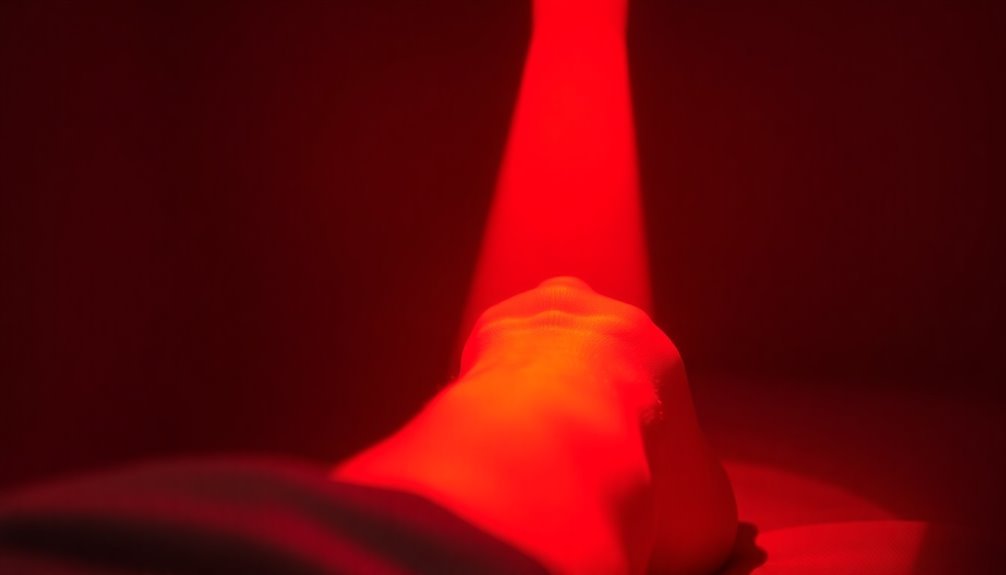
You’ll notice improvements in joint pain within 2-4 weeks when following a consistent red light therapy schedule of several sessions per week, with some people experiencing relief after just a few treatments.
Each session typically runs between 10-15 minutes, making it a convenient addition to your daily routine.
Your post-treatment activities can include normal movement and exercise, as the therapy’s cellular benefits continue working to reduce inflammation and promote healing even after the session ends.
Recovery Progress Timeline
The recovery timeline after natural joint pain treatment typically unfolds across several distinct phases, each marked by specific milestones and activities.
During the first two weeks post-treatment, you’ll need to rest the affected area while managing inflammation. Don’t take anti-inflammatory medications, as they can interfere with the healing process.
- Weeks 2-4: You’ll start no-impact exercises like pool jogging or using an elliptical machine, focusing on gentle movement without stressing the treated area.
- Weeks 4-6: You can add light resistance training and moderate stretching activities, but avoid compression exercises like squats.
- Weeks 6-12: You’ll progress to aerobic exercises while monitoring your body’s response and using heat or ice as needed.
- Months 3-6: The treatment reaches peak effectiveness, making this period vital for proper exercise progression.
Throughout your recovery, you’ll gradually increase activity levels while being mindful not to overexert yourself. Remember that stem cells are most potent between three to six months after treatment, so it’s vital to support their work by avoiding undue stress during exercises.
If you experience pain, stop the activity and adjust your routine accordingly.
Treatment Length Per Session
Natural joint pain treatments differ substantially in session duration and recovery timelines, with each therapy offering distinct advantages.
Acupuncture sessions typically last 20 to 60 minutes, with initial treatments scheduled weekly or bi-weekly. As your symptoms improve, you can expect these sessions to taper off to a maintenance schedule.
Laser therapy offers flexibility in treatment duration, ranging from just 5 minutes for red light therapy to 75 minutes for more intensive treatments. You’ll often experience immediate pain relief, with benefits lasting from several days to months. Daily short sessions prove more effective than irregular longer ones.
If you’re considering Scrambler Therapy, you’ll need to commit to 50-minute sessions, typically scheduled daily for up to 10 treatments. While you’ll notice short-term relief initially, multiple sessions can lead to continuous pain remission. The therapy’s effectiveness builds over time, and you might need occasional booster sessions to maintain results.
Each treatment’s efficacy depends on your specific condition and how you respond to therapy. You’ll find that consistency in attending sessions is vital for building cumulative therapeutic effects and achieving maximum pain relief.
Post-Treatment Activity Benefits
Engaging in post-treatment activities delivers significant benefits for joint pain recovery, with both immediate and long-term advantages. When you combine physical activity with light therapy treatments, you’ll experience enhanced healing and improved joint function.
Your body responds to this combination by triggering natural pain-relief mechanisms and promoting tissue repair through increased blood flow.
The most notable improvements you’ll notice include:
- Reduced pain sensitivity and inflammation, as exercise normalizes pain signals while releasing natural pain-relieving endorphins
- Better joint mobility and strength, supported by red and infrared light therapy’s ability to stimulate blood flow
- Enhanced sleep quality and reduced fatigue, helping your body recover more efficiently
- Decreased dependency on pain medication through sustainable, natural pain management
You’ll find that maintaining regular physical activity post-treatment helps prevent chronic pain development while supporting long-term joint health. This approach not only addresses immediate discomfort but also contributes to your overall well-being through improved mood and reduced anxiety.
Cellular Healing Mechanisms
Through advanced light therapy techniques, your body’s cellular healing mechanisms can be activated to provide natural joint pain relief. When red and near-infrared light penetrates your tissue, it targets your cells’ mitochondria, boosting ATP production and energizing cellular repair processes.
Your body’s healing response includes multiple pathways that work together to reduce pain and inflammation. The light therapy triggers increased blood flow to your affected joints, delivering essential nutrients and oxygen while activating anti-inflammatory mechanisms.
You’ll benefit from reduced levels of pro-inflammatory cytokines as your cells shift toward producing anti-inflammatory compounds.
The cellular response extends beyond basic inflammation control. Light therapy stimulates your body’s natural pain-relief systems by inhibiting purinergic receptors and enhancing adenosine signaling. It’s also affecting your TRP receptors, which play a key role in how you perceive pain.
In addition, you’re getting protection against joint tissue erosion through the inhibition of metalloprotein enzymes, helping preserve your joint function. The therapy’s ability to reduce oxidative stress while promoting tissue repair makes it an effective natural solution for managing joint pain without medication.
Alternative Pain Management Options
Alternative pain management strategies provide you with numerous drug-free options for joint relief. You’ll find both traditional and modern approaches that can effectively reduce discomfort without relying on medications.
From physical therapies to mind-body techniques, these methods work by targeting different aspects of pain management and healing.
- Physical therapy and exercise therapy strengthen your joints and improve flexibility, while specialized movements help reduce pressure on affected areas.
- Acupuncture and bioelectric therapy block pain signals to your brain, offering relief particularly for conditions like fibromyalgia and osteoarthritis.
- Ice, heat, and elevation techniques provide immediate relief for acute joint pain, while therapeutic touch and manual therapies address deeper tissue concerns.
- Mind-body practices such as yoga, tai chi, and meditation help you manage pain through improved body awareness and stress reduction.
You can combine these approaches for enhanced effectiveness. For instance, pair physical therapy with mindfulness practices, or complement manual therapies with heat treatment.
Remember to consult healthcare providers before starting any new pain management routine, especially when dealing with chronic joint conditions. These natural approaches often work best as part of an extensive treatment strategy tailored to your specific needs.
Safety Protocol For Light Therapy
While exploring natural pain relief methods, you’ll want to pay special attention to safety when using light therapy treatments.
Always choose FDA-approved devices and follow the manufacturer’s instructions precisely regarding power settings and exposure times.
You’ll need to wear proper protective eyewear designed specifically for laser therapy to prevent eye injuries. Make sure you’re using medical-grade eye shields during LED treatments.
Keep the treatment area well-ventilated to avoid heat buildup, and clean your skin thoroughly before sessions, removing any lotions or creams.
Don’t undergo light therapy if you’re taking anti-inflammatory medications, have thyroid conditions, or are dealing with skin growths that could be cancerous.
If you’ve recently had Botox, wait at least 5 days before treatment, and extend that to 7 days if you’ve used steroids.
Pregnant or breastfeeding women should get physician approval before starting therapy.
Position the device at the recommended distance and duration specified by the manufacturer.
You’ll also need to verify your device’s quality, checking for proper wavelength consistency and LED strength.
Future of Joint Pain Relief
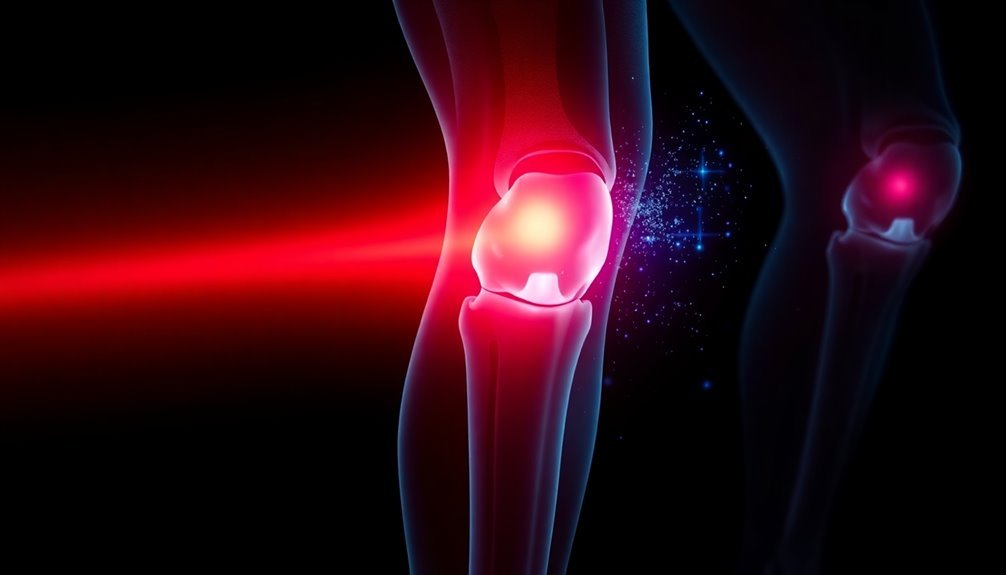
Three groundbreaking technologies are reshaping the future of joint pain relief. You’ll soon benefit from advanced nerve mapping that creates detailed 3D models of your knee joint’s sensory networks, leading to more precise and effective non-opioid treatments.
Coupled with self-healing joint therapies and gene-based solutions, these innovations will revolutionize how you manage joint pain.
Research initiatives like the NIH HEAL program and ARPA-H’s $39 million investment are accelerating the development of transformative treatments. You’ll see these emerging technologies in your doctor’s office sooner than you might think:
- Nanoparticle delivery systems that transport regenerative therapies directly to your joints through simple IV infusions
- Virtual reality environments that help you manage pain through immersive distraction techniques
- Personalized pain management plans powered by artificial intelligence, considering your unique genetic makeup
- Electromagnetic field therapy devices that naturally moderate nerve activity without medication
The integration of these technologies with existing treatments like light therapy and spinal cord stimulation will create exhaustive pain management solutions. You’ll have access to more effective, personalized, and non-invasive options that target the root cause of joint pain rather than just masking symptoms.
Frequently Asked Questions
Can Red Light Therapy Help With Nerve-Related Conditions Like Sciatica?
Yes, you’ll find red light therapy can help with sciatica by reducing inflammation, promoting tissue healing, and improving nerve function. It’s a non-invasive treatment that penetrates deep to stimulate cellular repair.
How Does Weather Affect the Effectiveness of Light Therapy Treatments?
You’ll find that daylength and temperature can impact your light therapy’s effectiveness. While cloudy skies may reduce results, it’s primarily the duration of natural daylight that influences your treatment’s overall success.
Are There Any Dietary Recommendations to Enhance Light Therapy Results?
You’ll get better light therapy results by eating anti-inflammatory foods, staying hydrated, and taking omega-3s. Focus on fiber-rich foods, antioxidants, and avoid processed foods, sugars, and excessive alcohol.
Can Light Therapy Help Prevent Future Joint Problems in Young Athletes?
Yes, you’ll benefit from light therapy’s preventive effects. It reduces inflammation, enhances muscle recovery, and promotes joint health. When used regularly, it can help protect your joints from future sports-related problems.
Does Skin Pigmentation Affect the Absorption Rate of Light Therapy?
Yes, your skin’s melanin level directly affects light therapy absorption. If you’ve got darker skin, you’ll need adjusted treatment parameters, as melanin can absorb or block certain wavelengths of therapeutic light.
In Summary
You’ve discovered a powerful, natural approach to managing joint pain through therapeutic light wavelengths. While you shouldn’t abandon conventional treatments entirely, red light therapy offers a promising complement to your pain management routine. Research continues to validate its effectiveness at the cellular level, and as technology advances, you’ll likely see more accessible and refined light therapy options. Consider discussing this treatment with your healthcare provider to determine if it’s right for you.




Leave a Reply